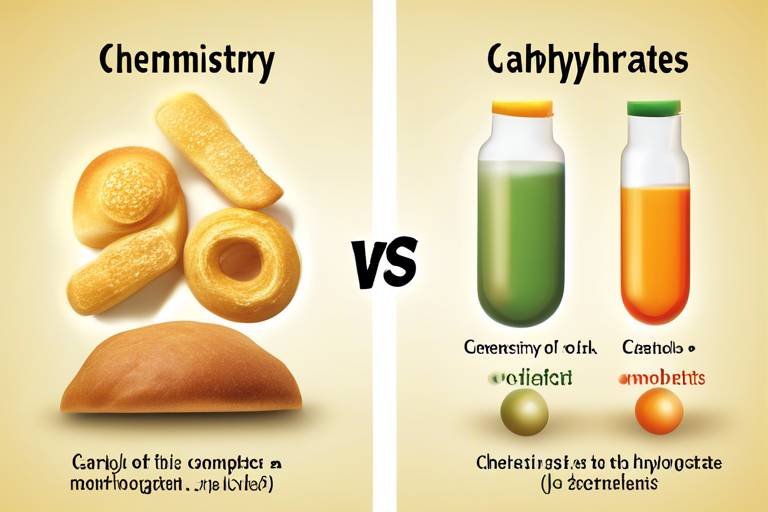The Chemistry of Carbohydrates - Simple vs. Complex
Carbohydrates are more than just a dietary staple; they are the body's primary source of energy, fueling everything from your morning jog to your brain's complex functions. In this article, we explore the fundamental differences between simple and complex carbohydrates, diving deep into their structures, functions, and impacts on health. Understanding these differences is crucial as they play a significant role in our daily nutrition and overall well-being.
Carbohydrates are essential macronutrients that serve as a primary energy source for the body. They are organic compounds made up of carbon, hydrogen, and oxygen, and they can be classified into two main categories: simple and complex carbohydrates. Simple carbohydrates, often referred to as sugars, are quickly absorbed by the body, providing immediate energy. On the other hand, complex carbohydrates consist of longer chains of sugar molecules and offer a more sustained energy release. This section delves into the different types of carbohydrates, their structures, and their roles in human nutrition.
When you think of simple carbohydrates, think of quick energy. These sugars are easily digestible and can spike your blood sugar levels rapidly. They are found in a variety of foods, from fruits to processed snacks. The chemical structure of simple carbohydrates is straightforward, consisting of one or two sugar units, making them easy for the body to break down. However, while they can provide a quick boost, they can also lead to energy crashes if consumed in excess.
There are various types of simple carbohydrates, which can be categorized into two main groups: monosaccharides and disaccharides. Each type has its own unique structure and function:
- Monosaccharides: These are the most basic form of carbohydrates, consisting of single sugar units. Common examples include glucose, fructose, and galactose. They are easily absorbed into the bloodstream and are vital for energy production.
- Disaccharides: Formed by the combination of two monosaccharides, disaccharides include sucrose (table sugar), lactose (milk sugar), and maltose. They also provide energy but require a bit more time for digestion compared to monosaccharides.
Monosaccharides are the simplest form of carbohydrates, consisting of single sugar units. They are the building blocks for more complex carbohydrates and play a crucial role in energy production. For example, glucose is essential for cellular respiration, providing the energy needed for various bodily functions. Other common monosaccharides include fructose, found in fruits, and galactose, which is part of lactose in dairy products.
Disaccharides are formed when two monosaccharides bond together. They include substances like sucrose, which is made of glucose and fructose, and lactose, composed of glucose and galactose. These sugars are often found in various foods, such as table sugar and milk. While they provide a quick energy source, it’s important to consume them in moderation, as excessive intake can lead to health issues.
Now, let's talk about the elephant in the room: the health effects of consuming simple carbohydrates. While they can provide a quick energy boost, an over-reliance on these sugars can lead to potential risks like obesity and diabetes. When you consume too many simple carbs, your body may struggle to regulate blood sugar levels, leading to spikes and crashes that can leave you feeling sluggish. It’s all about moderation and balance. Incorporating simple carbohydrates from natural sources, like fruits, can provide essential nutrients while still satisfying your sweet tooth.
Complex carbohydrates, in contrast, consist of longer chains of sugar molecules and provide sustained energy. They are typically found in whole grains, legumes, and vegetables. Because of their intricate structure, complex carbs take longer to digest, resulting in a gradual release of glucose into the bloodstream. This slow release helps maintain stable energy levels and keeps you feeling full longer, making them an essential part of a balanced diet.
Complex carbohydrates can be categorized into two main types: starches and fibers.
- Starches: These are long chains of glucose molecules and are found in foods like potatoes, rice, and whole grains. They serve as an excellent source of energy.
- Fibers: Unlike starches, fibers cannot be digested by the body. They play a crucial role in digestive health, helping to regulate bowel movements and prevent constipation.
Fiber is a crucial component of complex carbohydrates that aids digestion. It is essential for maintaining a healthy gut, preventing various diseases, and even aiding in weight management. By incorporating fiber-rich foods into your diet, you can enhance your overall health and well-being. Foods high in fiber include fruits, vegetables, whole grains, and legumes. Not only do they help keep your digestive system running smoothly, but they also contribute to a feeling of fullness, reducing the likelihood of overeating.
Q1: What are the main differences between simple and complex carbohydrates?
A1: The primary difference lies in their structure and how quickly they are digested. Simple carbohydrates are made up of one or two sugar units and are quickly absorbed, while complex carbohydrates consist of longer chains of sugar molecules, providing sustained energy over time.
Q2: Are all simple carbohydrates bad for health?
A2: Not necessarily. While many processed foods high in simple sugars can lead to health issues, natural sources like fruits contain essential nutrients and fiber, making them a healthier choice.
Q3: How can I incorporate more complex carbohydrates into my diet?
A3: You can include whole grains, legumes, and plenty of fruits and vegetables in your meals. Opting for brown rice instead of white rice or whole-grain bread instead of white bread are simple changes that can make a big difference.

Understanding Carbohydrates
Carbohydrates are essential macronutrients that play a pivotal role in fueling our bodies. Think of them as the body's primary energy source, much like gasoline fuels a car. Without adequate carbohydrates, our bodies can feel sluggish and fatigued, making it difficult to perform daily tasks. But what exactly are carbohydrates, and why are they so important? Let's dive into the world of carbs and uncover their different types and functions.
Carbohydrates can be broadly categorized into two main types: simple carbohydrates and complex carbohydrates. Simple carbohydrates, often referred to as sugars, are quickly absorbed by the body, providing a quick burst of energy. On the other hand, complex carbohydrates consist of longer chains of sugar molecules, which take more time to break down, offering a more sustained energy release. This fundamental difference in structure leads to varying effects on our blood sugar levels and overall health.
When we consume carbohydrates, our bodies convert them into glucose, which is used for energy. This process is vital for brain function, muscle activity, and overall metabolic processes. However, not all carbohydrates are created equal. While simple carbohydrates can be found in fruits, milk, and sweeteners, complex carbohydrates are abundant in whole grains, legumes, and vegetables. Understanding the sources and types of carbohydrates can help us make informed dietary choices that support our health.
Here’s a quick breakdown of the two types of carbohydrates:
| Type of Carbohydrate | Examples | Function |
|---|---|---|
| Simple Carbohydrates | Glucose, fructose, sucrose | Quick energy source |
| Complex Carbohydrates | Starch, fiber, glycogen | Sustained energy, digestive health |
In addition to providing energy, carbohydrates also play a significant role in various bodily functions. For instance, fiber, a type of complex carbohydrate, is crucial for digestive health. It helps regulate bowel movements, prevent constipation, and can even lower cholesterol levels. Moreover, carbohydrates are essential for the synthesis of certain amino acids and fatty acids, which are vital for overall health.
In conclusion, carbohydrates are more than just a source of energy; they are fundamental to our overall well-being. By understanding the differences between simple and complex carbohydrates, we can make better choices that fuel our bodies effectively and promote long-term health. So, the next time you reach for a snack, consider whether it’s a quick sugar rush or a more sustained energy boost that you need!

Simple Carbohydrates Explained
When we talk about simple carbohydrates, we're diving into the world of sugars that our bodies can absorb quickly. These carbohydrates are like the instant coffee of the food world – they give you a quick boost of energy, but they might not keep you going for long. Simple carbohydrates are typically made up of one or two sugar molecules, making them easy for your body to break down and utilize. This rapid absorption means they can spike your blood sugar levels, providing a quick source of energy, but they can also lead to a crash later on, leaving you feeling sluggish.
So, what exactly are these simple carbohydrates? They can be found in a variety of foods, from fruits to sweets. When you think about it, they are everywhere! For instance, fructose is a simple sugar found in fruits, while glucose is another common one that your body uses for energy. Then we have sucrose, which is table sugar and is often added to many processed foods. Here’s a quick breakdown of the two main types of simple carbohydrates:
| Type | Description | Examples |
|---|---|---|
| Monosaccharides | The simplest form of carbohydrates, consisting of single sugar units. | Glucose, Fructose, Galactose |
| Disaccharides | Formed by the combination of two monosaccharides. | Sucrose, Lactose, Maltose |
While simple carbohydrates can be beneficial when consumed in moderation, overindulging can lead to some serious health concerns. Think about it: when you consume too many sugary snacks or drinks, you might experience a quick energy surge, but then comes the dreaded energy crash. This cycle can lead to cravings for more sugar, creating a rollercoaster effect on your energy levels. Furthermore, a diet high in simple carbohydrates can increase the risk of obesity, type 2 diabetes, and other metabolic issues.
It's essential to be mindful of your intake. Instead of reaching for that candy bar or sugary drink, consider opting for natural sources of simple carbohydrates, such as fruits. Not only do they provide quick energy, but they also come packed with vitamins, minerals, and fiber, making them a much healthier choice. In essence, while simple carbohydrates can be a part of our diet, the key is to choose wisely and consume them in moderation.
In summary, simple carbohydrates are a double-edged sword. They offer quick energy but can lead to health issues if consumed excessively. By understanding their structure and sources, we can make informed choices that benefit our overall health. So the next time you reach for a snack, think about how it fits into your daily nutrition and energy needs!

Types of Simple Carbohydrates
When we talk about simple carbohydrates, we’re diving into the world of sugars, which are the building blocks of energy for our bodies. These carbohydrates can be categorized into two main types: monosaccharides and disaccharides. Understanding these types is crucial because they play different roles in our nutrition and overall health. Think of them as the quick fuel that powers our daily activities, but with varying effects on our body depending on their structure and source.
Monosaccharides are the simplest form of carbohydrates, consisting of single sugar molecules. They are often referred to as the "single units" of sugar. Common examples include glucose, fructose, and galactose. Glucose, for instance, is a primary source of energy for our cells, while fructose is found naturally in fruits and honey. These sugars are quickly absorbed into the bloodstream, providing an instant energy boost. However, their rapid absorption can lead to spikes in blood sugar levels, which is something to keep in mind, especially for those managing diabetes or insulin sensitivity.
On the other hand, disaccharides are formed when two monosaccharides join together through a process called glycosidic bonding. This category includes well-known sugars like sucrose (table sugar), lactose (the sugar found in milk), and maltose (commonly found in malted foods). Each of these disaccharides has its unique taste and source. For example, sucrose is derived from sugar cane or sugar beets, while lactose is present in dairy products. When we consume disaccharides, our bodies break them down into their monosaccharide components before they can be utilized as energy.
To summarize the key differences between monosaccharides and disaccharides, here’s a quick table:
| Type | Composition | Examples | Sources |
|---|---|---|---|
| Monosaccharides | Single sugar unit | Glucose, Fructose, Galactose | Fruits, Honey, Vegetables |
| Disaccharides | Two sugar units | Sucrose, Lactose, Maltose | Sugar Cane, Milk, Malted Foods |
Incorporating simple carbohydrates into your diet can provide quick energy, but it’s essential to choose sources wisely. Fruits, for instance, offer not only sugars but also vital nutrients and fiber, making them a healthier option compared to processed sugars found in candies and sodas. So, the next time you reach for a snack, consider the type of simple carbohydrate you’re consuming. Are you fueling your body with a natural source, or are you opting for something that might lead to a sugar crash later on?

Monosaccharides
Monosaccharides are the simplest form of carbohydrates, consisting of single sugar units. These tiny powerhouses play a crucial role in our body’s energy production and are often referred to as the "building blocks" of more complex carbohydrates. Imagine them as the individual Lego pieces that can be combined in various ways to create larger structures. The most common monosaccharides include glucose, fructose, and galactose, each with its own unique properties and functions.
Glucose, often dubbed the "blood sugar," is essential for providing energy to our cells. It’s like the gasoline that fuels a car; without it, our body wouldn’t function optimally. Fructose, on the other hand, is found primarily in fruits and honey, giving them their sweet taste. It’s important to note that while fructose is natural, excessive consumption, especially from processed sources, can lead to health issues. Galactose, the lesser-known monosaccharide, is primarily found in dairy products and is vital for various bodily functions, including the formation of certain lipids and glycoproteins.
Monosaccharides are not just about energy; they also have significant roles in metabolic processes. For instance, once consumed, these sugars are rapidly absorbed into the bloodstream, causing a quick spike in blood sugar levels. This swift absorption is why they are often referred to as "simple sugars." However, while they can provide an immediate energy boost, they can also lead to crashes if consumed in excess. It’s like riding a roller coaster; the ups are exhilarating, but the downs can leave you feeling drained.
Here’s a quick comparison of the three main monosaccharides:
| Monosaccharide | Source | Function |
|---|---|---|
| Glucose | Found in fruits, vegetables, and honey | Primary energy source for cells |
| Fructose | Fruits, honey, and root vegetables | Sweetener, energy source |
| Galactose | Dairy products | Part of lactose, important for cellular functions |
Understanding monosaccharides is vital for making informed dietary choices. While they are essential for energy, moderation is key. Consuming them in their natural form, such as through fruits and vegetables, is preferable over processed sugars found in candies and sodas. This approach not only provides the necessary energy but also comes with additional nutrients and fiber that enhance overall health.
1. What are monosaccharides?
Monosaccharides are the simplest form of carbohydrates, consisting of single sugar units like glucose, fructose, and galactose.
2. How do monosaccharides affect blood sugar levels?
Monosaccharides are quickly absorbed into the bloodstream, leading to rapid increases in blood sugar levels, which can provide quick energy but may also cause crashes if consumed excessively.
3. Are monosaccharides healthy?
In moderation and from natural sources like fruits and vegetables, monosaccharides can be part of a healthy diet, providing essential energy and nutrients.

Disaccharides
Disaccharides are fascinating compounds formed by the union of two monosaccharides, creating a more complex sugar that plays a vital role in our diet. Think of them as dynamic duos in the world of carbohydrates, where the combination of two simple sugars results in a molecule that not only tastes sweet but also serves essential functions in our body. The most common disaccharides include sucrose, lactose, and maltose, each bringing unique flavors and health benefits to our table.
To break it down, disaccharides are created through a process called dehydration synthesis, where a water molecule is removed to bond two monosaccharides together. This reaction is crucial because it allows for the formation of more complex sugars that our bodies can utilize for energy. For instance, when you enjoy a delicious glass of milk, the lactose present is a disaccharide that provides a quick source of energy. On the other hand, sucrose, which you might recognize as table sugar, is derived from sugar cane or sugar beets and is commonly used in various culinary applications.
Here’s a quick overview of some common disaccharides and their sources:
| Disaccharide | Composition | Common Sources |
|---|---|---|
| Sucrose | Glucose + Fructose | Table sugar, fruits, vegetables |
| Lactose | Glucose + Galactose | Milk, dairy products |
| Maltose | Glucose + Glucose | Barley, malted foods, beer |
Understanding the sources of disaccharides is crucial for making informed dietary choices. While they can provide quick energy, it’s important to consume them in moderation, especially if you have specific health concerns like lactose intolerance. The body breaks down disaccharides into their monosaccharide components before they can be absorbed into the bloodstream, which means they can lead to rapid spikes in blood sugar levels if consumed excessively.
In summary, disaccharides are not just sweeteners; they are essential components of our nutrition that contribute to our energy levels and overall health. By recognizing their sources and understanding their effects, we can make better choices for our dietary needs. So, the next time you enjoy a sweet treat or a glass of milk, you'll know exactly what’s happening at the molecular level!
- What are disaccharides? Disaccharides are carbohydrates formed by the combination of two monosaccharides, such as glucose and fructose.
- What are some common examples of disaccharides? Common examples include sucrose (table sugar), lactose (milk sugar), and maltose (found in malted foods).
- How does the body digest disaccharides? The body breaks down disaccharides into their monosaccharide components before absorption, which can lead to quick spikes in blood sugar levels.
- Are disaccharides healthy? While they can provide energy, it's important to consume disaccharides in moderation, especially for individuals with dietary restrictions.

Health Implications of Simple Carbohydrates
When it comes to simple carbohydrates, the conversation often shifts towards their health implications. While these sugars can provide a quick energy boost, they also come with a set of potential risks that we need to be aware of. Imagine consuming a sugary snack; it’s like a rollercoaster ride for your blood sugar levels—an exhilarating ascent followed by a dizzying drop. This rapid fluctuation can lead to feelings of fatigue and hunger shortly after consumption, prompting you to reach for more sugary foods.
One of the primary concerns surrounding simple carbohydrates is their link to obesity. Regularly consuming high amounts of sugary foods can lead to an imbalance in energy intake versus energy expenditure. When the body receives more calories than it burns, the excess is stored as fat. Over time, this can result in weight gain and, ultimately, obesity. The World Health Organization recommends that added sugars should comprise less than 10% of total daily energy intake. In fact, many health experts suggest aiming for even lower levels for optimal health.
Moreover, simple carbohydrates can significantly influence our risk of developing type 2 diabetes. Frequent spikes in blood sugar levels can lead to insulin resistance, where the body's cells become less responsive to insulin. This condition can pave the way for diabetes, a chronic disease that affects millions worldwide. The American Diabetes Association emphasizes the importance of monitoring carbohydrate intake, particularly simple sugars, to maintain healthy blood sugar levels.
It's not just about diabetes and obesity; consuming excessive amounts of simple carbohydrates can also affect your heart health. A diet high in sugars can lead to increased triglyceride levels, which are a risk factor for heart disease. Research suggests that individuals who consume high amounts of sugar-sweetened beverages have a greater risk of developing cardiovascular diseases.
However, it’s essential to remember that not all simple carbohydrates are created equal. Naturally occurring sugars found in fruits and dairy products come packaged with vitamins, minerals, and fiber, making them a healthier choice compared to refined sugars found in candies and sodas. Therefore, moderation is key. It’s about finding a balance that allows you to enjoy the sweet things in life without compromising your health.
In summary, while simple carbohydrates can provide quick energy, their health implications are serious. By being mindful of our intake and opting for healthier sources, we can enjoy the benefits of carbohydrates without falling into the traps of obesity, diabetes, and heart disease. Remember, knowledge is power, and understanding the impact of what we eat is the first step towards better health.
- What are simple carbohydrates? Simple carbohydrates are sugars that are quickly absorbed by the body, providing immediate energy.
- How do simple carbohydrates affect blood sugar levels? They can cause rapid spikes and drops in blood sugar, leading to fatigue and increased hunger.
- Are all simple carbohydrates unhealthy? Not necessarily. Naturally occurring sugars in fruits and dairy are healthier options compared to refined sugars.
- What are the risks of consuming too many simple carbohydrates? Excessive intake can lead to obesity, type 2 diabetes, and heart disease.

Complex Carbohydrates Overview
When we think about carbohydrates, our minds often jump to the quick energy sources like candies or sugary drinks. However, complex carbohydrates are the unsung heroes of our diets, providing not just energy but also a range of health benefits that are crucial for our well-being. Unlike their simple counterparts, complex carbohydrates consist of longer chains of sugar molecules, which means they take longer to digest and provide a more sustained release of energy. This slow digestion is like a marathon runner pacing themselves, ensuring they have the stamina to finish strong rather than sprinting out of the gate and burning out quickly.
Complex carbohydrates can be found in a variety of foods, including whole grains, legumes, vegetables, and fruits. These foods not only fuel our bodies but also come packed with essential vitamins and minerals. For instance, whole grains like brown rice and quinoa provide not just energy but also fiber, which is vital for digestive health. Eating a diet rich in complex carbohydrates can help maintain stable blood sugar levels, making them an excellent choice for those looking to manage their weight or reduce the risk of chronic diseases.
One of the key benefits of complex carbohydrates is their ability to promote satiety. When you consume foods high in complex carbs, you often feel fuller for longer periods. This is because they take longer to break down in the digestive system, leading to a gradual release of glucose into the bloodstream. In contrast, simple carbohydrates can cause quick spikes in blood sugar, followed by crashes that leave you feeling hungry again shortly after. Think of complex carbohydrates as a reliable friend who always has your back, providing you with steady energy throughout the day.
To further illustrate the differences between simple and complex carbohydrates, let’s take a look at the following table:
| Type of Carbohydrate | Examples | Digestion Speed | Health Benefits |
|---|---|---|---|
| Simple Carbohydrates | Table sugar, honey, fruit juice | Fast | Quick energy boost |
| Complex Carbohydrates | Whole grains, legumes, vegetables | Slow | Sustained energy, improved digestion |
Incorporating complex carbohydrates into your diet is not just about making healthy choices; it’s about making smart choices. The fiber found in many complex carbohydrate sources aids in digestion and helps prevent constipation, while also playing a role in reducing the risk of heart disease and diabetes. So, the next time you're planning your meals, think about adding some whole grains, beans, or a hearty vegetable dish. Your body will thank you!
In conclusion, complex carbohydrates are a vital part of a balanced diet. They not only provide energy but also contribute to overall health and wellness. By understanding the importance of these carbs, you can make informed choices that support your health goals.
- What are complex carbohydrates? Complex carbohydrates are long chains of sugar molecules that take longer to digest, providing sustained energy.
- What foods are high in complex carbohydrates? Foods such as whole grains, legumes, vegetables, and fruits are rich in complex carbohydrates.
- How do complex carbohydrates benefit health? They promote satiety, stabilize blood sugar levels, and provide essential nutrients and fiber.
- Can I eat complex carbohydrates if I'm trying to lose weight? Yes! They can help you feel full longer, making it easier to manage your weight.

Types of Complex Carbohydrates
Complex carbohydrates are like the sturdy, reliable friends of the nutrition world. They consist of long chains of sugar molecules, which means they take longer for your body to break down and digest. This slow release of energy makes them an excellent choice for maintaining stable blood sugar levels and providing lasting fuel for your daily activities. Now, let's dive into the two main types of complex carbohydrates: starches and fibers.
Starches are the most common type of complex carbohydrate and are found in foods like potatoes, rice, pasta, and whole grains. Think of starches as the fuel tanks of your diet; they fill you up and provide energy for your body to function efficiently. When you consume starches, your body breaks them down into glucose, which is then used for energy. However, not all starches are created equal! For example, whole grains contain more nutrients and fiber compared to refined grains, making them a better choice for long-lasting energy.
On the other hand, we have fibers, which are the unsung heroes of complex carbohydrates. Unlike starches, fibers are not digested by the body, but they play a crucial role in maintaining digestive health. They can be further divided into two categories: soluble fiber and insoluble fiber. Soluble fiber dissolves in water and can help lower cholesterol levels, while insoluble fiber adds bulk to your stool and helps prevent constipation. Foods rich in fiber include fruits, vegetables, legumes, and whole grains. Incorporating these foods into your diet can lead to a healthier gut and may even reduce the risk of chronic diseases.
In summary, both starches and fibers are essential components of a balanced diet. They not only provide energy but also support digestive health and overall well-being. By choosing whole food sources of complex carbohydrates, you can enjoy the benefits of sustained energy and improved health. Remember, the next time you reach for a snack, opt for something that fuels your body effectively, like a bowl of oatmeal or a hearty vegetable soup!
- What are complex carbohydrates? Complex carbohydrates are long chains of sugar molecules that provide sustained energy and are found in foods like whole grains, legumes, and vegetables.
- How do complex carbohydrates differ from simple carbohydrates? Simple carbohydrates are quickly absorbed by the body and can cause rapid spikes in blood sugar, while complex carbohydrates are digested more slowly, providing a steady release of energy.
- Why is fiber important in our diet? Fiber aids digestion, helps regulate blood sugar levels, and can reduce the risk of chronic diseases such as heart disease and diabetes.

The Role of Fiber
Fiber is often regarded as the unsung hero of the carbohydrate world. While many people focus on sugars and starches, fiber quietly works in the background, playing a crucial role in maintaining our overall health. It’s like the sturdy backbone of a house, providing structure and support to our digestive system. But what exactly does fiber do, and why should we care about it? Let’s dive into the fascinating world of fiber and uncover its many benefits.
First off, fiber can be broken down into two main categories: soluble and insoluble fiber. Soluble fiber dissolves in water and forms a gel-like substance in the gut. This type of fiber is known for its ability to help lower cholesterol levels and stabilize blood sugar, making it a key player in heart health and diabetes management. On the other hand, insoluble fiber does not dissolve in water. Instead, it adds bulk to our stool and helps food pass more quickly through the digestive tract, which is essential for preventing constipation. Think of it as a broom that sweeps everything along, keeping our digestive system running smoothly.
Now, you might be wondering where you can find this magical fiber. It’s abundant in a variety of foods, making it easy to incorporate into your diet. Some excellent sources of soluble fiber include:
- Oats
- Beans and lentils
- Fruits like apples and citrus
- Barley
Meanwhile, insoluble fiber can be found in:
- Whole grains
- Nuts and seeds
- Vegetables such as carrots and broccoli
- Whole grain bread and pasta
Consuming an adequate amount of fiber is not just a suggestion; it’s a necessity! The recommended daily intake for adults is about 25 grams for women and 38 grams for men. However, most people fall short of these numbers. This shortage can lead to various health issues, including digestive problems, heart disease, and even certain types of cancer. Imagine your body as a finely tuned machine; without the right fuel—in this case, fiber—it can’t operate at peak performance.
Moreover, fiber is known for its role in weight management. High-fiber foods tend to be more filling, which can help curb overeating. When you eat foods rich in fiber, you’re likely to feel satisfied longer, reducing the temptation to snack on unhealthy options. It’s like having a loyal friend who keeps you on the right track, helping you resist those sugary treats that can derail your health goals.
In addition to its digestive benefits, fiber also plays a significant role in maintaining gut health. It acts as a prebiotic, feeding the good bacteria in our intestines. A healthy gut microbiome is linked to numerous health benefits, including improved immunity and even better mental health. It’s fascinating to think that the tiny microorganisms living in our gut can influence our mood and overall well-being!
So, how can you easily boost your fiber intake? Start by making small changes to your diet. Swap out white bread for whole grain, add a side of vegetables to every meal, or snack on fruits and nuts instead of chips. These simple adjustments can lead to significant health improvements over time. Remember, incorporating fiber into your diet is not just about adding more foods; it’s about making smarter choices that benefit your body in the long run.
In conclusion, fiber is a vital component of a balanced diet, contributing to digestive health, weight management, and overall well-being. By understanding its role and making a conscious effort to include more fiber-rich foods in your meals, you’re setting yourself up for a healthier future. So, let’s raise a toast to fiber—the hidden gem of carbohydrates!
1. What are the health benefits of fiber?
Fiber aids digestion, helps maintain a healthy weight, lowers cholesterol, stabilizes blood sugar levels, and supports gut health by feeding beneficial bacteria.
2. How can I increase my fiber intake?
You can increase your fiber intake by consuming whole grains, fruits, vegetables, legumes, nuts, and seeds. Gradually adding these foods to your diet can help you meet your daily fiber needs.
3. Are there any risks associated with consuming too much fiber?
While fiber is essential for health, excessive intake can lead to digestive issues, such as bloating and gas. It’s best to increase fiber intake gradually and drink plenty of water.
4. Can fiber help with weight loss?
Yes, high-fiber foods are more filling and can help control appetite, making it easier to manage weight. They often require more chewing and take longer to eat, which can contribute to a feeling of fullness.
Frequently Asked Questions
- What are carbohydrates and why are they important?
Carbohydrates are essential macronutrients that serve as a primary energy source for the body. They play a crucial role in fueling our daily activities and maintaining overall health. Without adequate carbohydrates, our bodies may struggle to function optimally.
- What is the difference between simple and complex carbohydrates?
Simple carbohydrates, often called sugars, are quickly absorbed by the body and provide immediate energy. In contrast, complex carbohydrates consist of longer chains of sugar molecules, which take longer to digest, providing sustained energy over time. Think of simple carbs as a quick snack, while complex carbs are more like a hearty meal that keeps you full longer.
- Can you give examples of simple carbohydrates?
Sure! Common examples of simple carbohydrates include glucose, fructose, and sucrose. You can find these sugars in foods like fruits, honey, and table sugar. They are sweet and provide a quick energy boost, but it's important to consume them in moderation.
- What are the health implications of consuming too many simple carbohydrates?
Consuming excessive amounts of simple carbohydrates can lead to health issues such as obesity, insulin resistance, and diabetes. These sugars can cause rapid spikes in blood sugar levels, which can be harmful over time. Moderation is key to maintaining a balanced diet.
- What are complex carbohydrates and where can I find them?
Complex carbohydrates are made up of longer chains of sugar molecules and are found in foods like whole grains, legumes, and vegetables. They provide a steady release of energy and are packed with nutrients, making them a vital part of a healthy diet.
- What role does fiber play in our diet?
Fiber is a crucial component of complex carbohydrates that aids in digestion and helps maintain gut health. It can prevent constipation and lower the risk of chronic diseases like heart disease and diabetes. Including fiber-rich foods in your diet is essential for overall well-being.
- How can I incorporate more complex carbohydrates into my meals?
Incorporating more complex carbohydrates is easy! Opt for whole grain bread instead of white bread, choose brown rice over white rice, and include a variety of fruits and vegetables in your diet. These small changes can significantly enhance your nutrition.



















